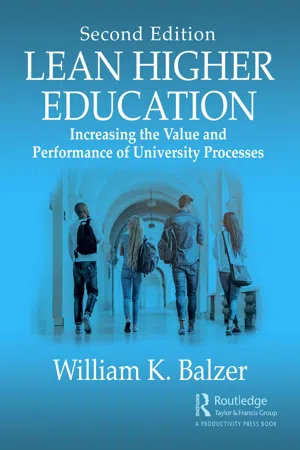
Lean Higher Education
Increasing the Value and Performance of University Processes, Second Edition
- 406 pages
- English
- ePUB (mobile friendly)
- Available on iOS & Android
Lean Higher Education
Increasing the Value and Performance of University Processes, Second Edition
About This Book
In an environment of diminishing resources, growing enrollment, and increasing expectations of accountability, Lean Higher Education: Increasing the Value and Performance of University Processes, Second Edition provides the understanding and the tools required to return education to the consumers it was designed to serve – the students. It supplies a unifying framework for implementing and sustaining a Lean Higher Education (LHE) transformation at any institution, regardless of size or mission.
Using straightforward language, relevant examples, and step-by-step guidelines for introducing Lean interventions, this authoritative resource explains how to involve stakeholders in the delivery of quality every step of the way. The author details a flexible series of steps to help ensure stakeholders understand all critical work processes. He presents a wealth of empirical evidence that highlights successful applications of Lean concepts at major universities and provides proven methods for uncovering and eliminating activities that overburden staff yet contribute little or no added value to stakeholders.
Complete with standardized methods for correctly diagnosing workplace problems and implementing appropriate solutions, this valuable reference arms you with the understanding and the tools to effectively balance the needs of all stakeholders. By implementing the Lean practices covered in these pages, your school will be better positioned to provide higher quality education, at reduced costs, with efficient processes that instill pride, maximize value, and respect the long-term interests of your students, faculty, and staff.
This second edition contains a substantial update with expanded material and reflects the significant growth of LHE practices in colleges and universities worldwide. Because of advances in best practices, as well as some modest research-based evidence, this second edition includes many enhancements that provide particular value to LHE practitioners and higher education (HE) leaders.
Since the initial publication of Lean Higher Education in 2010, the challenges of cost and affordability, competition for students and faculty, and calls for efficiency and accountability have only continued to grow, requiring colleges and universities to pursue more radical and transformative change to ensure their success. This new edition provides a model for change based on more than 50 years of application in business and industry and almost 20 years in HE. It provides the information and evidence demanded by HE leadership to understand and embrace LHE as well as best practices processes and tools for implementing LHE in targeted areas or institution-wide. This book provides a conceptual framework for redesigning any university process, such as admitting students, paying a bill, hiring faculty, or processing a donor gift, in a way that delights the beneficiary of that process, respects the employees who support the process, and reduce the cost of the process.
A free companion guide to this book is available here:
https://cabaa139-7c62-47ae-af03-e18f51efab1c.filesusr.com/ugd/f5359d_a064ca39f666408f851ffd282eb9a0a7.pdf
The goal of this companion guide is to help you get the most out of your reading of Lean Higher Education. The guide is designed to support your deeper understanding and application of LHE whether you are reading the book (a) from cover to cover or select chapters; (b) reading it alone, as a member of a workplace reading group, or as a student in a classroom; (c) facilitating discussions of the chapters in the book; or (d) seeking guidance as you begin your own personal Lean Higher Education journey.
Frequently asked questions
Information
Chapter 1
The Case for Lean Higher Education
For most American colleges and universities, the pendulum has swung from the heyday of growth, prosperity, and public favor to new times that call for institutions to adapt themselves to current, harsher realities…. The challenges of institutional change presented by the new environment are daunting. For institutions to be successful, change must be both intentional and continuous.1In the current low-growth period, market competition has become increasingly fierce – a battle of life and death. In such an environment, strengthening the character of business is an absolute requirement for survival.2
1.1 The Need for Change in Higher Education
1.1.1 Scenario 1: Approval of a New or Modified Course
1.1.2 Scenario 2: Installing a Door in a Faculty Research Laboratory
1.1.3 Scenario 3: Thank You Notes to Donors
Table of contents
- Cover
- Half Title
- Title Page
- Copyright Page
- Dedication
- Contents
- Preface to the Second Edition
- Preface to the First Edition
- Acknowledgments
- Author
- Introduction to the Second Edition
- 1 The Case for Lean Higher Education
- 2 Lean Higher Education in Practice: An Overview and Case Study
- 3 Evidence Supporting the Successful Application of LHE
- 4 Preparing for the Successful Adoption and Implementation of LHE
- 5 Preparing for the Rapid Improvement Event
- 6 Conducting, Implementing, and Sustaining the Rapid Improvement Event
- 7 Lean Academic Processes
- 8 Making the Case for LHE: Gaining the Support of Senior Leaders
- 9 Realizing the Promise of LHE
- Appendix A
- Index